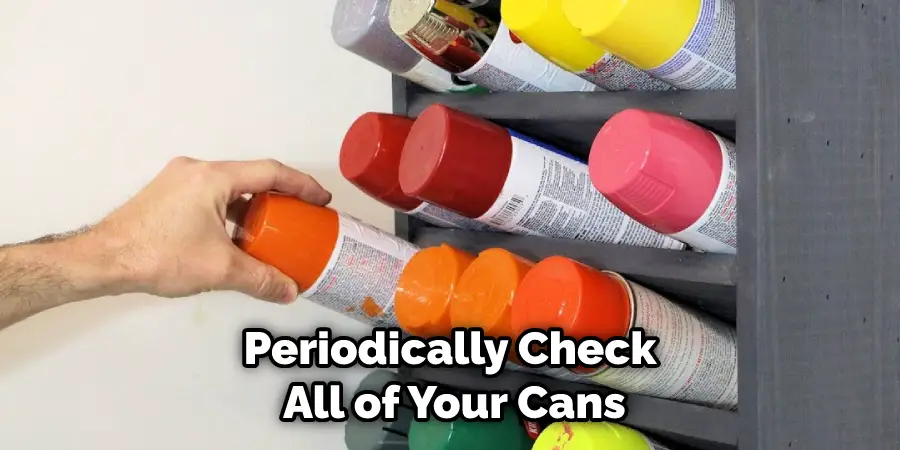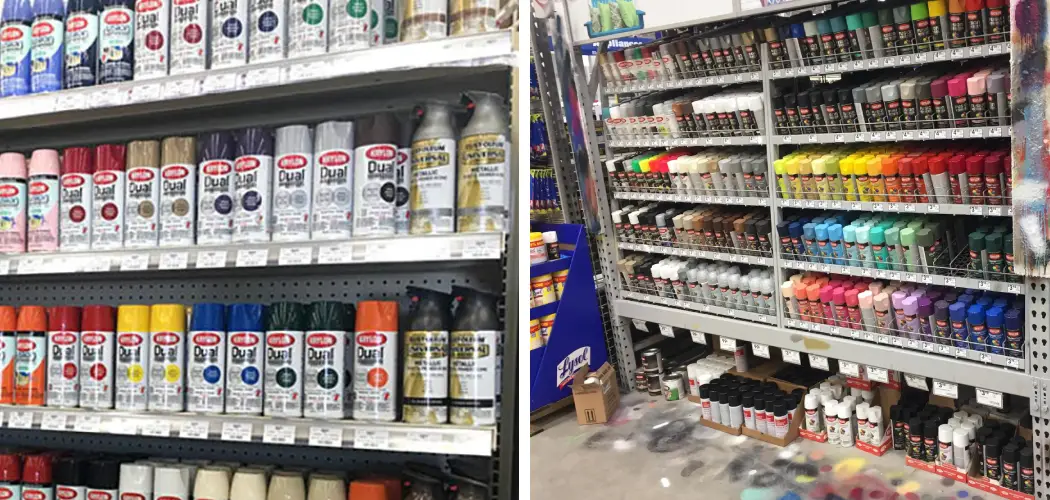Storing spray paint correctly can greatly extend a spray can’s life and help avoid costly replacements. Correct storage also helps prevent accidental spraying or leaking, which could lead to injury or property damage. Also, proper storage ensures that your cans are in good condition for future use.

Storing spray paint correctly can have several advantages. One advantage is that it will help you maintain the quality and performance of the paint for a longer time.
Proper storage also prevents the paint from becoming contaminated, which could lead to an uneven application when using it. Additionally, storing your cans properly will help prevent them from leaking or exploding in extreme temperatures. In this blog post, You will learn how to store spray paint in detail.
Step-by-Step Processes for How to Store Spray Paint
Step 1: Inspect All Cans of Spray Paint
Before storing your cans of spray paint, it is important to inspect each one for any damage or leaks. If any are found, discard them immediately and do not use them. Once all of the intact cans have been identified, it is important to clean each one by wiping off the lids and any residue from the outside of the cans.
Step 2: Store in a Cool, Dry Place

Spray paint should be stored in a cool, dry place that is away from direct sunlight or heat sources to prevent it from becoming too hot. To further protect your spray paint, it is recommended to store them in an airtight container such as a plastic bin or box. This will help keep any moisture, dirt, and dust away from the paint cans.
Step 3: Place Upright in Racks or Shelves
Place your spray paint cans upright on racks or shelves instead of laying them flat to ensure proper storage. This will help prevent any leakage or spills and keep the nozzle unclogged. To make it easier to identify your cans, use labels to indicate the type of paint inside each one. This way, you can easily find the color and brand you need when using them.
Step 4: Keep Away from Small Children and Pets
Make sure to keep your spray paint away from small children and pets at all times, as they can easily ingest the paint or injure themselves if they get a hold of it. It is not recommended to store your spray paint cans in the garage or basement, as these areas are often exposed to extreme temperatures and humidity.
Step 5: Check Often for Leaks
Periodically check all of your cans of spray paint for any signs of leakage or damage, and discard them if needed. Once the spray paint cans have been emptied, be sure to dispose of them properly in accordance with your local laws and regulations. This will help keep your home and environment safe from hazardous chemicals.

Following these steps for storing spray paint can ensure that you can stay in good condition for longer and that your home is free from any hazardous chemicals.
Tips for How to Store Spray Paint
- Store spray paint away from any ignition sources, such as open flames, cigarettes, and heaters.
- Use a well-ventilated area to store the spray paint cans and ensure no direct sunlight hits them.
- Keep the lids of spray paint cans securely closed when not in use to prevent gases from escaping and air from entering the can.
- Store spray paint cans in a safe, secure location away from children and pets.
- Make sure the temperature of the storage area is between 50˚F – 104˚F (10˚C – 40˚C), as extreme temperatures may cause the paint to thicken, leak or explode.
- If possible, store spray paint cans upside down to prevent clogging of the nozzle.
- Store unused and used aerosol cans separately so that you don’t accidentally pick up a can of used paint instead of fresh paint.
- Dispose of old spray paint cans in accordance with regulations in your area. Never store or dispose of a can containing paint in a manner that could be potentially hazardous to the environment.
Following these tips will help you store spray paint responsibly and safely. Pay attention to the labels on the cans, as they may have additional safety information, which should always be followed.
How Should You Store Spray Paint in Order to Keep It From Freezing or Becoming Too Hot?
When storing spray paint, it’s important to keep it at a temperature that won’t cause the paint to freeze or become too hot. Ideally, you should store your spray paint in a cool, dry place with temperatures between 50 and 70 degrees Fahrenheit (10 to 21 degrees Celsius). Don’t store your cans near vents or sources of heat like heating ducts, dryers, or stoves. Also, avoid direct sunlight, as this could cause the paint to become too hot and runny.
You also want to ensure that your spray paint cans are sealed tightly and stored upright on a shelf or in a cabinet. This prevents any air from getting inside the can and drying out the contents. Store cans in a well-ventilated area, away from open flames or other sources of heat. If you’re storing spray paint for the winter, it’s best to store it indoors in an unheated space.
The garage or basement can be great options if temperatures don’t drop below freezing. If you must store your spray paint outdoors, place it in a cool, dry area and cover it with a tarp or plastic bag to protect it from the elements.
How Can You Avoid Spilling Spray Paint When Moving Containers?
When storing spray paint, it’s important to avoid spilling the liquid. This is especially true if you move containers of spray paint from one place to another. To help ensure that your stored spray paint does not spill, there are a few steps you can take:

- Make sure all lids and caps on the containers are tightly closed.
- Place each container in a plastic bag before moving it to prevent any potential spills from transferring onto other items or surfaces.
- Use extra caution when moving containers of spray paint, as sudden movements can cause the contents to slosh around and spill out.
- If possible, place the sealed containers of spray paint in a box or other sturdy container before moving them.
- Keep the containers upright and avoid tilting them at sharp angles when transporting them. This will reduce the risk of spillage from occurring.
Following these tips will help you to store spray paint more safely and securely when moving it from place to place. It’s also important to remember that spray paint is a flammable material and should be handled carefully.
How Do You Clean Up Any Spills That Occur During Storage?
If you find that a spill has occurred during storage, it is important to clean it up right away. First, remove any excess spray paint using paper towels or rags. Then, use warm water mixed with mild detergent to clean the area and let it air dry. If the spill is on fabric or carpet, apply a spot cleaner or dry cleaning solvent and vacuum it up after it has dried.

Be sure to follow the directions on the product carefully. Ensure you wear gloves and proper ventilation when using any solvents or cleaners to avoid dangerous fumes. Finally, once the area is completely dry, apply a sealant or protectant to help prevent future spills from staining the surface. By following these steps, you can ensure that your spray paint is properly stored and any spills are quickly cleaned up.
What Can You Do to Prevent Your Stored Spray Paint From Going Bad?
One of the most important things to remember when it comes to storing spray paint is that air can ruin the product. To ensure your stored spray paint has a longer shelf life, keep it in an airtight container and store it in a cool, dry location away from direct sunlight and heat sources. It’s also wise to check the expiration date on the container of your spray paint before you purchase it.
The expiration date on spray paint is important because, after that date, the solvents and propellants inside can start to break down and cause clogs or other problems with using the product. In addition, if you have opened a can of spray paint, be sure to properly reseal it completely before storing it.
This will keep the paint from drying out and help keep it usable for longer periods of time. Finally, once you have used your spray paint, make sure to clean and maintain its nozzle with a dry cloth before storing or disposing of it. Keeping the nozzle of your spray paint free of dirt and debris and properly storing it will help ensure its longevity.
How Often Should You Check on the Condition of Your Stored Spray Paint?
It is important to check the condition of stored spray paint every three to four months since environmental changes – such as temperature and humidity levels – can significantly affect the performance of the paint. Visual inspection should be done to look for signs of cracking or bubbling on the surface of the cans.
If any irregularities are found, it is advised that they can be discarded and replaced as soon as possible. Additionally, cans should be periodically shaken to ensure the paint is well-mixed before use.

Lastly, always wearing appropriate safety gear, such as gloves and a face mask, when handling spray paint cans is important. Doing so will prevent inhaling hazardous fumes or accidental contact with the paint. By following these tips, you can ensure that your stored spray paint remains in good condition and ready to use whenever it is needed. Properly storing your spray paint cans will also help extend their shelf life and maximize the value of your investment.
Conclusion
Though spray paint can be convenient and easy to use, several disadvantages are associated with storing it. Firstly, spray paint cans must be stored in a cool and dry place away from direct sunlight as the heat can cause the paint to expand, potentially leading to a burst of pressure which could cause an explosion or fire. Furthermore, spray paints can be prone to rusting and corrosion if stored in a damp or humid environment, leading to clogged nozzles.
In conclusion, knowing to store spray paint correctly is essential for preventing it from drying out or becoming unusable. Whether you’re storing it in its original container, transferring it into an air-tight plastic container, or keeping it stored away in a cool, dry place – following these steps can save you money and hassle down the line. I hope this article has been beneficial in learning how to store spray paint. Make Sure the precautionary measures are followed chronologically.
About
Angela is the chief editor of Indoorense. She began her career as an interior designer before applying her strategic and creative passion to lifestyle and home.
She has close to 15 years of experience in creative writing and online content strategy for housekeeping and cleaning,home decorations as well as other efforts.
She loves her job and has the privilege of working with an extraordinary team. She lives with her husband, two sons, and daughter in Petersburg. When she’s not busy working she spent time with her family.

